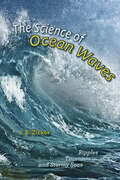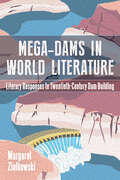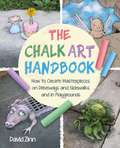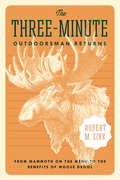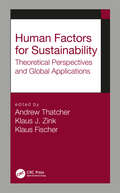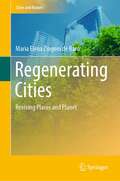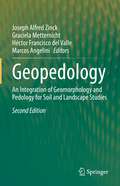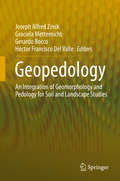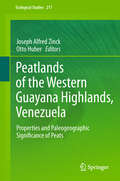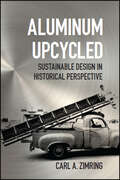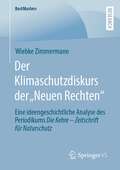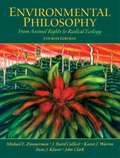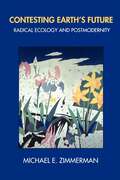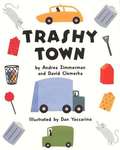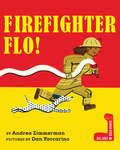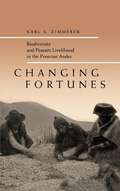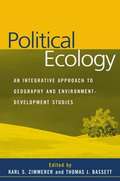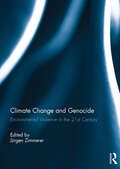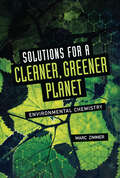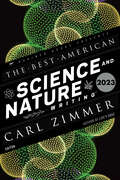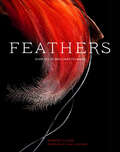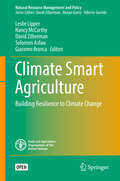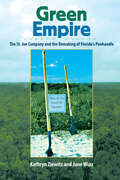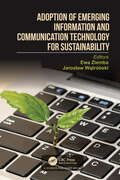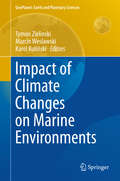- Table View
- List View
The Science of Ocean Waves: Ripples, Tsunamis, and Stormy Seas
by J. B. ZirkerAn unparalleled introduction to the amazing world of ocean waves.Outstanding Academic Title, Choice"Powerful ocean waves fascinate the public, and they have made a lot of news lately." With that indisputable observation, scientist J. B. Zirker takes off on a whirlwind tour of the world of waves—from the "ordinary" waves that constantly churn the sea to the rogues or freaks that can rise up seemingly from nowhere to heights of 20 meters or more... and everything in between.Addressing questions most ocean visitors have had and offering new ones for our consideration, The Science of Ocean Waves explains in accessible language how waves are formed, how they move, how they become huge and destructive, and how they're being studied now for clues that will help us plan for the future.Devoting chapters to wind, tides, currents, breakers, tsunamis, forecasting, renewable energy, and El Niño—as well as discussing the gentler properties of ocean waves which inspire us and offer opportunities for relaxation and recreation—Zirker explores the physical factors that create waves.Drawing on some of the recent storms that have devastated entire regions—such as Hurricane Katrina, the tsunami launched by the 2004 Sumatran earthquake, and the great tsunami that crushed the shore of Japan in 2011—Zirker explains the forces that cause these monster waves and reveals the toll they take on human lives.Enhanced by dozens of illustrations and a comprehensive glossary, The Science of Ocean Waves will fascinate anyone curious about the science behind the headlines.Praise for J. B. Zirker"Scientists know their stuff but are rarely good storytellers, whereas good storytellers rarely possess the necessary sweeping command of a scientific discipline. Zirker is that rare animal who can both communicate the most demanding technical detail and make it accessible."—New Scientist
Mega-Dams in World Literature: Literary Responses to Twentieth-Century Dam Building
by Margaret ZiolkowskiMega-Dams in World Literature reveals the varied effects of large dams on people and their environments as expressed in literary works, focusing on the shifting attitudes toward large dams that emerged over the course of the twentieth century. Margaret Ziolkowski covers the enthusiasm for large-dam construction that took place during the mid-twentieth-century heyday of mega-dams, the increasing number of people displaced by dams, the troubling environmental effects they incur, and the types of destruction and protest to which they may be subject. Using North American, Native American, Russian, Egyptian, Indian, and Chinese novels and poems, Ziolkowski explores the supposed progress that these structures bring. The book asks how the human urge to exploit and control waterways has affected our relationships to nature and the environment and argues that the high modernism of the twentieth century, along with its preoccupation with development, casts the hydroelectric dam as a central symbol of domination over nature and the power of the nation state. Beyond examining the exultation of large dams as symbols of progress, Mega-Dams in World Literature takes a broad international and cultural approach that humanizes and personalizes the major issues associated with large dams through nuanced analyses, paying particular attention to issues engendered by high modernism and settler colonialism. Both general and specialist readers interested in human-environment relationships will enjoy this prescient book.
The Chalk Art Handbook: How to Create Masterpieces on Driveways and Sidewalks and in Playgrounds
by David ZinnA comprehensive guide for chalk art creators! With so many searching for ways to have fun at home in the midst of the Covid-19 pandemic, chalk art has become a great way to do so while enjoying some fresh air. The Chalk Art Handbook offers budding artists a review of the tools involved, as well as tips and tricks to creating an array of sidewalk creatures. Artist David Zinn, whose work has been used as inspiration for elementary and middle school art lessons, offers step-by-step guidance on how to make chalk art come to life and advice on specific techniques such as smudging, perspective, and 3-D illusions. He also encourages artists to work outside the box with details on how to best incorporate concrete specks and natural holes or cracks in the ground into their artwork. The Chalk Art Handbook even includes bonus activities to keep everyone drawing happily both indoors and outdoors. The perfect gift for those looking for hours of outdoor fun!
The Three-Minute Outdoorsman Returns: From Mammoth on the Menu to the Benefits of Moose Drool
by Robert M. ZinkSpending time in nature can raise some serious questions. After contemplating your own mortality, you may start to wonder: Why don’t deer noses freeze in the winter? What does mammoth taste like? Do fish feel pain? These are important questions, and Robert M. Zink has the answers. Bringing together the common and the enigmatic, The Three-Minute Outdoorsman Returns includes over seventy three-minute essays in which Zink responds to the queries that have yet to cross your mind. Drawing on his zoological background, Zink condenses the latest scientific discoveries and delivers useful, entertaining information on the great outdoors. Can a sheep’s horns be too big? Was the Labrador duck a hybrid? Why did I miss that clay target? A large section on deer covers topics ranging from deer birth control backfiring, new information on Chronic Wasting Disease, supplemental feeding, and deer genetics. Other essays explore land, aquatic animals, and humanity’s relationship with nature, thus making this book of wild science an essential for any outdoors person.
Human Factors for Sustainability: Theoretical Perspectives and Global Applications
by Klaus J. Zink Andrew Thatcher Klaus FischerThis book deals with the central question of how human factors and ergonomics (HFE) might contribute to solutions for the more sustainable development of our world. The contents of the book are highly compatible with the recent political agenda for sustainable development as well as with sustainability research from other disciplines. <P><P>The book aims to summarize and profile the various empirical and theoretical work arising from the field of “Human Factors and Sustainable Development” in the last decade. The book gives a systematic overview of relevant theoretical concepts, their underlying philosophies, as well as global application fields and case studies.
Regenerating Cities: Reviving Places and Planet (Cities and Nature)
by Maria Elena Zingoni de BaroThis book sets out the discussion on how cities can contribute solutions to some of the challenges the urbanised world is facing, such as the pressure of growing populations, mitigation of effects of, and adaptation to globally changing environmental, climate and public health conditions. Presenting a detailed explanation of the causes behind the current state of modern cities, the book advocates for a paradigm shift to improve the quality of life of ever-increasing urban inhabitants whilst nourishing the natural systems that sustain human and non-human life in the planet. Recognising the precious role that nature plays in the functioning of cities, it delves into the study of biophilic design and regenerative development. The book argues that these social-ecological design approaches can act as catalysts to develop conditions in urban settings that are beneficial for natural and human systems to thrive and flourish, both in ecosystem services and social-cultural systems. This is particularly relevant for the design of new quality precincts or the regeneration of degraded urban spaces to promote health, wellbeing and urban resilience. A framework is proposed to guide the process of thinking about, designing and building healthier, more liveable and resilient urban environments that raise the quality of life in cities. The method can be used by researchers, practitioners -urban designers, urban planners, architects and landscape architects- interested in developing their work within a social-ecological perspective. It can also be used by local governments and agencies to underpin policy making, and by educational institutions to prepare graduates with necessary skills to respond to current and future built environment challenges.
Geopedology: An Integration Of Geomorphology And Pedology For Soil And Landscape Studies
by Joseph Alfred Zinck Graciela Metternicht Héctor Francisco del Valle Marcos Angelini<p>This updated and revised second edition brings geopedology issues into the current context. This new edition extends the work on popular topics such as digital soil mapping, GIS and landscape mapping, and it also gives valuable insight with up-to-date theoretical discussions and new application with relevant case studies. This textbook offers a proven approach for reliable mapping of soil-landscape relationships to derive information for policy, planning and management at scales ranging from local to regional. Filled with didactic elements such as case studies, visual aids (maps, charts and figures), questions and answers, the book is of interest to geohazard studies, land use conflict analysis, land use planning, land degradation assessment, and land suitability analysis.<p> <p>Soil is a vital resource for society at large and an important determinant of the economic status of nations. The intensification of natural disasters and the increased land use competition for food and energy have raised awareness of the relevant role the pedosphere plays in natural and anthropogenic environments. Recent papers and global initiatives show a renewed interest in soil research and its applications for improved planning and management of this fragile and finite resource.<p>
Geopedology
by Joseph Alfred Zinck Graciela Metternicht Gerardo Bocco Héctor Francisco Del ValleThis book offers a proven approach for reliable mapping of soil-landscape relationships to derive information for policy, planning and management at scales ranging from local to regional. It presents the theoretical and conceptual framework of the geopedologic approach and a bulk of applied research showing its application and benefits for knowledge generation relevant to geohazard studies, land use conflict analysis, land use planning, land degradation assessment, and land suitability analysis. Soil is a vital resource for society at large and an important determinant of the economic status of nations. The intensification of natural disasters and the increased land use competition for food and energy have raised awareness of the relevant role the pedosphere plays in natural and anthropogenic environments. Recent papers and global initiatives show a renewed interest in soil research and its applications for improved planning and management of this fragile and finite resource.
Peatlands of the Western Guayana Highlands, Venezuela
by Joseph Alfred Zinck Otto HuberThe Guayana Highlands in northeastern tropical America, rising from lowland rain forests and savannas up to 3000 m elevation, are characterized by ancient tablelands called tepuis. The peatlands that developed on the tepuis constitute unique and fascinating ecosystems and are the focus of this volume, which starts with an overview of tropical and subtropical peats, followed by an introduction to the geo-ecological features of the Guayana region as a whole, with special emphasis on the diversity of the vegetation cover from lowlands to uplands to highlands. The core subject centers on the properties and dating of the peat deposits and the interpretation of the chronological record in terms of past environmental changes. The well illustrated book will appeal to a broad range of scientists interested in tropical highland peats, including quaternarists, soil scientists, geomorphologists, geographers, geologists, ecologists, botanists, hydrologists, conservationists, and land use planners.
Aluminum Upcycled: Sustainable Design in Historical Perspective (Johns Hopkins Studies in the History of Technology)
by Carl A. ZimringTracing the benefits—and limitations—of repurposing aluminum.Besides being the right thing to do for Mother Earth, recycling can also make money—particularly when it comes to upcycling, a zero waste practice where discarded materials are fashioned into goods of greater economic or cultural value. In Upcycling Aluminum, Carl A. Zimring explores how the metal’s abundance after World War II—coupled with the significant economic and environmental costs of smelting it from bauxite ore—led to the industrial production of valuable durable goods from salvaged aluminum. Beginning in 1886 with the discovery of how to mass produce aluminum, the book examines the essential part the metal played in early aviation and the world wars, as well as the troubling expansion of aluminum as a material of mass disposal. Recognizing that scrap aluminum was as good as virgin material and much more affordable than newly engineered metal, designers in the postwar era used aluminum to manufacture highly prized artifacts. Zimring takes us on a tour of post-1940s design, examining the use of aluminum in cars, trucks, airplanes, furniture, and musical instruments from 1945 to 2015. By viewing upcycling through the lens of one material, Zimring deepens our understanding of the history of recycling in industrial society. He also provides a historical perspective on contemporary sustainable design practices. Along the way, he challenges common assumptions about upcycling’s merits and adds a new dimension to recycling as a form of environmental absolution for the waste-related sins of the modern world. Raising fascinating questions of consumption, environment, and desire, Upcycling Aluminum is for anyone interested in industrial and environmental history, discard studies, engineering, product design, music history, or antiques.
Der Klimaschutzdiskurs der „Neuen Rechten“: Eine ideengeschichtliche Analyse des Periodikums Die Kehre – Zeitschrift für Naturschutz (BestMasters)
by Wiebke ZimmermannUmwelt- wie auch konkret der Klimaschutz als dessen jüngerer Teilbereich sind weder neutrale Sachthemen noch notwendigerweise politisch links zu verorten. Im historischen Rückblick lassen sich Momente der geglückten wie gescheiterten Verquickung nationalistischer und antidemokratischer Positionen mit „grünen“ Forderungen im gesellschaftspolitischen Diskurs ausmachen. Auch im Lichte des gegenwärtigen Relevanzgewinns der Causa Klimawandel regen sich im neurechten Lager erneut die Versuche einer (Rück-)Eroberung der Diskurshoheit. Paradigmatisch hierfür steht das neurechte Periodikum Die Kehre – Zeitschrift für Naturschutz, das sich als Debattenort zur Etablierung einer „konservativen Ökologie“, der Verbindung von Ökologie mit rechtsideologischen Elementen, ins Werk setzt. Welche Positionen beziehen, welche Begründungzusammenhänge formulieren Akteur*innen der „Neuen Rechten“ zum Klimaschutz? Die vorliegende Arbeit rekonstruiert Amalgamierungsmomente neurechter (Vorläufer-)Gruppierungen mit Themen des Umweltschutzes und systematisiert so die Chronologie der Genese der „Neuen Rechten“ in einem umweltethischen Zusammenhang. Auf diesem Fundament wird eine Tiefenanalyse der klimaschutzpolitischen Argumentationen innerhalb des neurechten Periodikums Die Kehre geleistet, die identifizierten Positionen werden hinsichtlich ihrer inhaltlichen und strukturellen Brücken in neurechte Traditions- und Ideologiebestände kontextualisiert und interpretiert.
Environmental Philosophy: From Animal Rights to Radical Ecology
by Michael E. Zimmerman J. Baird Callicott John Clark Irene J. Klaver Karen J. WarrenEdited by leading experts in contemporary environmental philosophy, this anthology features the best available selections that cover the full range of positions within this rapidly developing field. Divided into four sections that delve into the vast issues of contemporary Eco-philosophy, the Fourth Edition now includes a section on Continental Environmental Philosophy that explores current topics such as the social construction of nature, and eco-phenomenology. Each section is introduced and edited by a leading philosopher in the field. For professionals with a career within the environmental field including law, politics, conservation, geography, and biology.
Contesting Earth's Future: Radical Ecology and Postmodernity
by Michael E. ZimmermanRadical ecology typically brings to mind media images of ecological activists standing before loggers' saws, staging anti-nuclear marches, and confronting polluters on the high seas. Yet for more than twenty years, the activities of organizations such as the Greens and Earth First! have been influenced by a diverse, less-publicized group of radical ecological philosophers. It is their work—the philosophical underpinnings of the radical ecological movement—that is the subject of Contesting Earth's Future.The book offers a much-needed, balanced appraisal of radical ecology's principles, goals, and limitations. Michael Zimmerman critically examines the movement's three major branches—deep ecology, social ecology, and ecofeminism. He also situates radical ecology within the complex cultural and political terrain of the late twentieth century, showing its relation to Martin Heidegger's anti-technological thought, 1960s counterculturalism, and contemporary theories of poststructuralism and postmodernity.An early and influential ecological thinker, Zimmerman is uniquely qualified to provide a broad overview of radical environmentalism and delineate its various schools of thought. He clearly describes their defining arguments and internecine disputes, among them the charge that deep ecology is an anti-modern, proto-fascist ideology. Reflecting both the movement's promise and its dangers, this book is essential reading for all those concerned with the worldwide ecological crisis.
Trashy Town
by Andrea Griffing Zimmerman David ClemeshaMeet Mr. Gilly. He cleans up Trashy Town. He does it with a big smile and a big truck--which is sure to make him a hero with all the children in the neighborhood. David Clemesha and Andrea Zimmerman have created a rhythmic, repeatable refrain that will roll off the lips of every child.
Firefighter Flo! (Big Jobs, Bold Women)
by Andrea ZimmermanRing! Clang! Firefighter Flo and her team race to stop a fire in this picture book filled with bold art and fun onomatopoeia.Last night at the Fire Station…With a jingly-jang, the telephone rang.RING-RING! RING-RING!Firefighter Flo jumps out of bed! There&’s a fire and only a pro like Flo and her team can help. Read along as the firefighters put on their fireproof suits, rush off in their truck, douse the fire with the big hose, and rescue the family pet. The CLANG of the siren and WHOOSH of the fire will have parents and kids reading aloud together.The Big Jobs, Bold Women series introduces even the youngest readers to women as leaders in unusual jobs with teams relying on them. The first in the series, Fire Flo makes this empowering message accessible with a showstopping art and story about a job every kid loves. With dynamic artwork from Dan Yaccarino, Nickelodeon character designer for The Backyardians, and energetic verse from Andrea Zimmerman, best-selling author of Trashy Town, Firefighter Flo is the perfect read for kids who love to watch the big red fire trucks rush by.
Changing Fortunes: Biodiversity and Peasant Livelihood in the Peruvian Andes (California Studies in Critical Human Geography #1)
by Karl S. ZimmererTwo of the world's most pressing needs—biodiversity conservation and agricultural development in the Third World—are addressed in Karl S. Zimmerer's multidisciplinary investigation in geography. Zimmerer challenges current opinion by showing that the world-renowned diversity of crops grown in the Andes may not be as hopelessly endangered as is widely believed. He uses the lengthy history of small-scale farming by Indians in Peru, including contemporary practices and attitudes, to shed light on prospects for the future. During prolonged fieldwork among Peru's Quechua peasants and villagers in the mountains near Cuzco, Zimmerer found convincing evidence that much of the region's biodiversity is being skillfully conserved on a de facto basis, as has been true during centuries of tumultuous agrarian transitions.Diversity occurs unevenly, however, because of the inability of poorer Quechua farmers to plant the same variety as their well-off neighbors and because land use pressures differ in different locations. Social, political, and economic upheavals have accentuated the unevenness, and Zimmerer's geographical findings are all the more important as a result. Diversity is indeed at serious risk, but not necessarily for the same reasons that have been cited by others. The originality of this study is in its correlation of ecological conservation, ethnic expression, and economic development.
Political Ecology
by Karl Zimmerer Thomas J. BassettThis volume offers a unique, integrative perspective on the political and ecological processes shaping landscapes and resource use across the global North and South. Twelve carefully selected case studies demonstrate how contemporary geographical theories and methods can contribute to understanding key environment-and-development issues and working toward effective policies. Topics addressed include water and biodiversity resources, urban and national resource planning, scientific concepts of resource management, and ideas of nature and conservation in the context of globalization. Giving particular attention to evolving conceptions of nature-society interaction and geographical scale, an introduction and conclusion by the editors provide a clear analytical focus for the volume and summarize important developments and debates in the field.
Climate Change and Genocide: Environmental Violence in the 21st Century
by Jürgen ZimmererClimate change caused by human activity is the most fundamental challenge facing mankind in the 21st century, since it will drastically alter the living conditions of millions of people, mainly in the Global South. Environmental violence, including resource crises such as peak fossil fuel, will lie at the heart of future conflicts. However, Genocide Studies have so far neglected this subject, due to the emphasis that traditional genocide scholarship places on ideology and legal prosecution, leading to a narrow understanding of the driving forces of genocide. This books aims at changing this, initiating a dialogue between scholars working in the areas of climate change and genocide. Research into genocide as well as climate change is a highly interdisciplinary endeavour, transcending the boundaries of established disciplines. Contributions to this book address this by approaching the subject from a wide array of methodological, theoretical, disciplinary and regional perspectives. As all the contributions show, climate change is a major threat multiplier for violence or non-violent destruction and any understanding of prevention needs to take this into account. They offer a basis for much needed Critical Prevention Studies, which aims at sustainable prevention.This book was originally published as a special issue of the International Journal of Human Rights.
Solutions for a Cleaner, Greener Planet: Environmental Chemistry
by Marc ZimmerMany of the most toxic materials on Earth—from arsenic to plutonium—occur naturally, but manufacturers have also used them in products such as paints, plumbing, pesticides, nuclear fuel, and weaponry. Without careful management, toxins can leach into groundwater or pollute our environment. Exposure to toxins leads to various cancers, impairment of the immune and reproductive systems, as well as cognitive problems. What can be done? Solutions include a wide range of infrastructure approaches, such as better water filtration, governmental and manufacturing regulations, outright bans on certain chemicals, careful monitoring, and the use of alternative fuels. Learn more about key contaminants and their impact on health, as well as solutions on a global and individual level.
The Best American Science and Nature Writing 2023 (Best American)
by Carl Zimmer Jaime GreenThe Best American Science and Nature Writing 2023 has descriptive copy which is not yet available from the Publisher.
Feathers: Displays of Brilliant Plumage
by Carl Zimmer Robert ClarkExquisite images from award-winning National Geographic photographer Robert Clark offer a captivating perspective on the vast beauty and myriad functions of a seemingly simple thing: the bird feather. Each detailed close-up is paired with informative text about the utility and evolution of the feather it depicts, making this handsome marriage of art and science the ideal book for bird lovers, natural history buffs, and photography enthusiasts.
Climate Smart Agriculture: Building Resilience to Climate Change (Natural Resource Management and Policy #52)
by David Zilberman Leslie Lipper Nancy Mccarthy Solomon Asfaw Giacomo BrancaThis book is open access under a CC BY-NC-SA 3. 0 IGO license. The book uses an economic lens to identify the main features of climate-smart agriculture (CSA), its likely impact, and the challenges associated with its implementation. Drawing upon theory and concepts from agricultural development, institutional, and resource economics, this book expands and formalizes the conceptual foundations of CSA. Focusing on the adaptation/resilience dimension of CSA, the text embraces a mixture of conceptual analyses, including theory, empirical and policy analysis, and case studies, to look at adaptation and resilience through three possible avenues: ex-ante reduction of vulnerability, increasing adaptive capacity, and ex-post risk coping. The book is divided into three sections. The first section provides conceptual framing, giving an overview of the CSA concept and grounding it in core economic principles. The second section is devoted to a set of case studies illustrating the economic basis of CSA in terms of reducing vulnerability, increasing adaptive capacity and ex-post risk coping. The final section addresses policy issues related to climate change. Providing information on this new and important field in an approachable way, this book helps make sense of CSA and fills intellectual and policy gaps by defining the concept and placing it within an economic decision-making framework. This book will be of interest to agricultural, environmental, and natural resource economists, development economists, and scholars of development studies, climate change, and agriculture. It will also appeal to policy-makers, development practitioners, and members of governmental and non-governmental organizations interested in agriculture, food security and climate change.
Green Empire: The St. Joe Company and the Remaking of Florida's Panhandle
by Kathryn Ziewitz June WiazSince the Great Depression, the St. Joe Company (formerly the St. Joe Paper Company) has been Florida's largest landowner, a forestry and transportation conglomerate whose influence has been commensurate with its holdings. The company owns nearly one million acres, mainly in northwestern Florida, where undeveloped coastal and riverside landscapes boast some of the state's most scenic and ecologically diverse areas. For 60 years, the company focused on growing trees, turning them into paper, and managing its ancillary businesses. In the late 1990s, the company shifted directions: it sold its paper mill, changed its name, and launched a concerted drive to turn its natural-resource assets into greater profits. Today the St. Joe Company is a critical and fiscally powerful force in the real-estate development of northwest Florida, with access to the most influential people in government. Based on hundreds of sources--including company executives, board members, and investors, as well as outside observers--this factual and balanced history describes the St. Joe Company from the days of its founders to the workings and dealings of its present-day heirs. For anyone concerned with land use and growth management, particularly those with an interest in Florida's fragile wildlife and natural resources, Green Empire will illuminate the issues surrounding the relationship between one of the most ambitious players in Florida's real-estate market and the state's last frontier.
Adoption of Emerging Information and Communication Technology for Sustainability
by Ewa Ziemba JarosławThis book represents an important voice in the discourse on the adoption of emerging ICT for sustainability. It focuses on how emerging ICT acts as a crucial enabler of sustainability, offering new forward-looking approaches to this field. The book explores how emerging ICT adoption drives sustainability efforts in business and public organizations, promoting ecological, economic, social, cultural, and political sustainability. The book's theoretical discussions, conceptual approaches, empirical studies, diverse perspectives, and views make it a valuable and comprehensive reference work. Appealing to both researchers and practitioners, this book provides significant areas for research and practice related to the contribution of emerging ICT adoption to sustainability. It also suggests vital considerations for programming and building sustainable development-driven emerging ICT adoption. Readers will find answers to important contemporary questions, such as: What are the concepts, frameworks, models, and approaches to enhance sustainable development through the adoption of emerging ICT? How does the adoption of emerging ICT influence sustainability? How can emerging ICT be adopted to enhance sustainability? What are the current practices and successful cases of emerging ICT adoption for sustainability? What factors influence emerging ICT adoption to enhance sustainability?
Impact of Climate Changes on Marine Environments
by Tymon Zielinski Marcin Weslawski Karol KulińskiThis book contributes to the current discussion on global environmental changes by discussing modifications in marine ecosystems related to global climate changes. In marine ecosystems, rising atmospheric CO2 and climate changes are associated with shifts in temperature, circulation, stratification, nutrient input, oxygen concentration and ocean acidification, which have significant biological effects on a regional and global scale. Knowing how these changes affect the distribution and abundance of plankton in the ocean currents is crucial to our understanding of how climate change impacts the marine environment. Ocean temperatures, weather and climatic changes greatly influence the amount and location of nutrients in the water column. If temperatures and currents change, the plankton production cycle may not coincide with the reproduction cycle of fish. The above changes are closely related to the changes in radiative forcing, which initiate feedback mechanisms like changes in surface temperature, circulation, and atmospheric chemistry.
